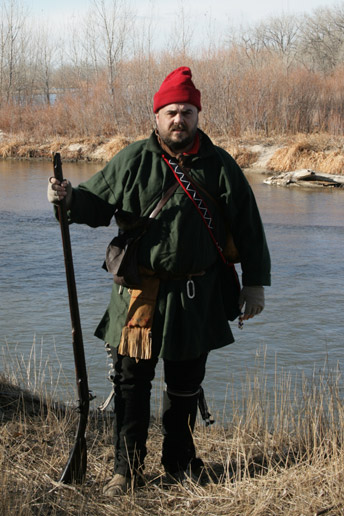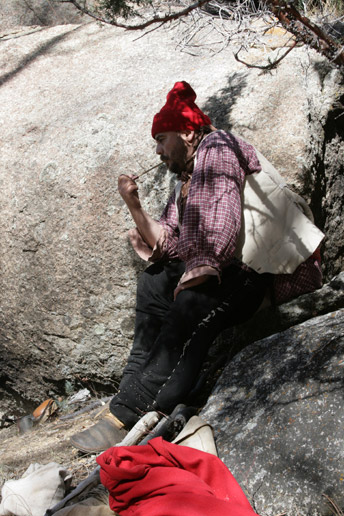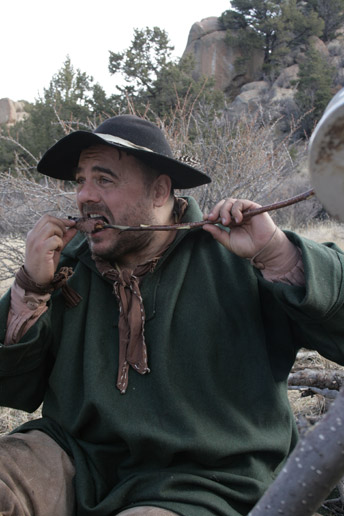Rocky Mountain Outfit — American Mountain Men (AMM) party of Colorado
Darko
My AMM Requirements
This is the documentation for the requirements that I have done to advance to a Bossloper member of the AMM. Officially I became a Pilgrim member of the AMM in July of 2010. I became a Bossloper February of 2012. My number is #2041.
-
Must have a full set of hand-cut and -sewn clothing and handmade
accoutrements. These must be researched for authenticity of the 1800-40
period and be of a type which would have been seen on men in, or moving
to, the Rocky Mountains. Rifles, saddles, traps, blankets, and other
accoutrements that would normally have required the work of a specialized
craftsman need not be handmade, but must be as authentic as can be
purchased today.
My persona is that of a scout / hunter / interpreter for the American Fur Company brigade moving trough the mountains — Rocky Mountain Outfit. I do also secretly gather information and spy on the AFCo company structure, trading practices, quality of trade goods, internal organization, relationship with the natives and satisfaction of the brigade members, on behalf of the Chouteau family from St. Louis.
Clothing:
 Along the South Platte River, January 2012
Along the South Platte River, January 2012
My favorite foot wear for spring, summer and autumn is center seam and side seam moccasins. When the weather turns cold I wear a large pair of greased, side seam moccasins and a pair of pucker toe moccasins and line these with a single or double layer of old wool blanket. My narrow fall style pantaloons are out of linen. They are covered with a pair of leather leggings or wool leggings in winter. The leggings are held up by a narrow leather whang to the sash or belt above. I have several shirt made of fustian or osnaburg. For the cold weather, I wear a heavy wool shirt and wool capote over it. Around my neck I wear a cotton cloth cravat. I do use cotton cloth bandana most of the time to cover my head, and in winter I have a wool toque. On occasion, I use wool felt hat. Leather belt, 2" wide and red wool sash complete the picture.
General Accoutrements:
My accoutrements consist of a 7 inch scalper knife in a very basic, stitched and closed with brass tacks leather sheath, secured by a buckskin whang wrapped around my belt. Under my belt I also carry my smoking pouch which also includes fire starting tools. Shooting pouch is of cow hide, hand stitched with linen thread. Contents within include balls, some shot, patching and tow, a measure made from the tip of an elk horn, vent pick and hammer for knapping flint, small container of sweet oil, and extra flint. I carry a simple trade powder horn with separate strap, both horn and bag under my right arm.
Main firearm is a 20 gauge flintlock smooth bore with 42-inch barrel, accompanied with 20 gauge flintlock smooth bore pistol. Both are of French background. I also use .54 cal Tennessee style flintlock that I use for hunting big game.
Plain English flat saddle covered with buffalo robe, plain leather stirrups and typical stirrup iron, and with folded wool blanket underneath the saddle is my riding gear. I do have and use simple snaffle bit and typical English reins when riding.
My camp gear consists of one 4-point wool blanket and one 3-point wool blanket. They are inside oil cloth covers and in winter I add a bear hide under the blankets and my saddles buffalo robe under my feet. I use additional 7x7' canvas tarp for overhead in bad weather. I do carry a hatchet for camp chores and wood fixing. For cooking I carry a tin kettle, brass kettle and tin cup, wood spoon and a small frying pan (not all kettles at the same time).
Literary resources I have used in developing and equipping my persona:
- Journal of a Trapper, Osborne Russell
- Life in the Rocky Mountains, Warren Ferris
- Wah-To-Yah and the Taos Trail, Lewis Garrard
- Supply and Demand, Oliver McCloskey and Scott "Doc Ivory" Olsen
- Forty Years a Fur Trader on the Upper Missouri, Charles Larpentuer
- Robiduox Chronicles, Hugh M. Lewis
- French Fur Traders and Voyageurs in the American West, Leroy R. Hafen
- Etienne Provost, Man of the Mountains, Jack B. Tykal
- Across the Rockies to the Columbia, John Kirk Townsend
- Heroes to Me, Mike Moore
- A View to the West, Mike Moore
- My Sixty Years on the Plains, William Thomas Hamilton
- Indian Sign Language, William Tomkins
-
Must have spent at least two days and one night in a primitive camp during each season of the year.
 Having a smoke, November 2010
Having a smoke, November 2010
Winter: January 15 – 17, 2011
AMM land winter camp with Bill G, Steve C, Rick L, Scott, Nathan, Tom and I. Mules and horses, mud and snow. Hiked 4 miles in the land, great camp and experience. Went on day scout around the property, shoot some balls, had a merry time. Animal packing and leading experience was great.
View sketches from this camp.Spring: March 25 – 27, 2011
Spring camp with Brad Bailey at Brad's Hole. Snowed on both nights, nice, sunny days. Saw deer, trout, geese, duck, deer, hawks, heard two owls talking to each other across the creek. Went beaver hunting, but had no luck.
View sketches from this camp.Summer: August 26 – 28, 2011
Wilderness camp in Middle Park, Rock Creek Meadow with Brad, Steve, Bill A, Cliff C and I. Scouting camp for the Nationals location. Spend some time in the meadows gathering and eating berries, wild strawberries and gooseberries, a lot of sugar and energy in those.
View sketches from this camp.Fall: October 21 – 23, 2011
Buffalo Peaks small game hunting camp with Brad, Zachary, Steve, Gabe, Bill A, Tom and I. Hunted squirrels and had a great time and beautiful scenery. Went around the ridges after small game. Had a great dog travois design, loading and harness setting lesson from Gabe and Tom, talked to bull elk over night and have them (by chance) come close to the camp.
View sketches from this camp. - Must have spent an accumulative time of two or more weeks in the wilderness under primitive conditions in the company of no more than one other member. Each stay must be at least three full days and two full nights.
- Must have spent at least one full week in a primitive encampment in the company of other members at the territorial AMM Rendezvous (Eastern or Western) and/or the National (Rocky Mountain) AMM Rendezvous.
-
Must be able to demonstrate the skills needed for primitive survival in
the wilderness of his area and must be willing to teach said skills to
other members when requested by a Party Booshway or Director of this
Association.
I have discussed and demonstrated different survival scenarios in our AMM camps and educational presentations, all seasons and different levels of difficulty. Shelter, food, water, my survival gear and knowledge of basic and primitive survival skills are very important to me and I continuously learn form literature and from field experience. On top of shelter survival scenarios, patience and clear mind, food providing and water purification methods, I have also learned from senior AMM brothers more about plants in this regions that are necessary in survival situations.
-
Must be able to demonstrate trapping ability using steel traps, snares,
and traps made from natural materials found in the area. As many states do
not allow the use of some, or any, of these traps, the actual taking of
game is not required, although it is suggested where possible and legal.
I own and use several leg traps and have used them in demonstrations to show how they work. I have also attended and learned trapping colleges during several AMM camps and fort educational presentations. Snare demonstration in small game hunting camp using my personal snare set. Due to Colorado laws, all trapping and snaring demonstrations are for show only, not for actual game harvest. I am looking forward to future opportunities to camp and trap with AMM brothers in other states that allow beaver trapping.
-
Must be able to demonstrate ability to track man or animal under natural
wilderness conditions.
I have tracked AMM party into the camp in Brad's Hole, and in every camp discussed and showed / recognized tracks of the different local animal life. I do hunt any chance I get, and try to recognize and follow animal tracks to harvest the game.
-
Must be able to demonstrate the ability to properly pack a horse, canoe
(or bullboat), or a man for distance travel under possible adverse
conditions.
I do pack all of my gear and carry it to camps on my back. It is always evolving experience and mostly I have been downsizing my gear to basic necessities in order to easy and fast pack and carry my gear. I do use tumpline for carrying my bedroll and haversack and knapsack for carrying other gear and food. When on day hunts / scouts, I use knapsack that includes survival necessities, and I tie a wool poncho / oilcloth poncho to it. I have helped others to pack horses for AMM camps, and canoes for non-AMM, but primitive camps.
-
Must be able to properly field dress (clean and skin) a game animal under
primitive conditions.
I've completed this skill numerous times in field. Last small game camp in October 2011, I skinned a squirrel and showed the process to several other members.
-
Must be able to start a fire in wet, as well as dry, weather using flint
and steel or fire drill using tinder and wood found under natural
conditions.
I have started fires in all conditions in every camp I attended using flint and steel and available local material. I do carry a small pack of dry tinder in my gear and I refill it all the time in field. I have also been in AMM camps when different methods of fire starting than with charcloth have been utilized, and I carry in my survival bag a few of survival pitch covered pine 'matches' that catch fire from flint embers and stay lit even if rained on.
- Must be able to show ability to tan or Indian-dress hides.
-
Must have spent at least five days traveling on foot, snowshoe, canoe,
and/or horseback.
- One method or a combination may be used.
- Bullboat may be used in place of canoe.
- You are expected to gain as much distance as possible.
- his trip must be under primitive conditions, taking nothing that would not have been available to the mountain man between 1800-1840. Rifle, hunting bag, powder horn, and knife must be along.
-
Must be able to cook a meal of meat using only the meat, fire, a knife, and materials found in nature.
 Meat on a stick, March 2011
Meat on a stick, March 2011
I have roasted meat in several camps using only local wood and knife, meat on a stick with a little bit of salt. In March 2011 in Brad's Hole I have made a full meal of meat on stick.
-
Must be able to converse using Plains Indians hand talk. The 200 words on
page 64 of Tompkin's book "Indian Sign Language", will be used as a basis
for conversation. To complete this requirement, you must demonstrate your
ability to read the signs for 50 words, as well as to give the signs for
50 words.
In AMM camps I practice with other AMM members and learn from them. I have used William Tomkin's book and practice with others. I have been tested by Brad Bailey and passed the same test similar to the tests performed in AMM Nationals Sign Language College for years.
-
Must have hunted for and killed at least one game or fur animal with a
muzzleloading firearm or primitive bow and must have used the skin and/or
meat for food, clothing and/or accoutrements. The hunt must be made from a
strictly primitive camp, the hunt accomplished under primitive conditions
within the limits of local game laws.
Although I have harvested big and small game in the last 15 years using black powder guns, for AMM requirements I have only to report that I have hunted, killed, skinned and cooked a good tasting squirrel at the camp in October 2011.
I want to thank all of AMM - RMO members for guiding me along through this process and for having patience with me and my strange French ways. Special thanks goes to Brad Bailey for all the companionship and knowledge he transferred unselfishly, and for his patience with my snoring, and to Bill Gantic for taking time and effort to accommodate my schedule and camp with me before I was even invited to become a member.
Jean Baptiste Darko
January 2012